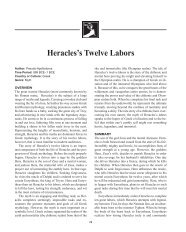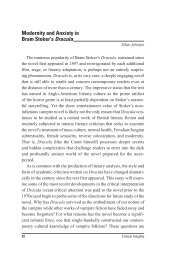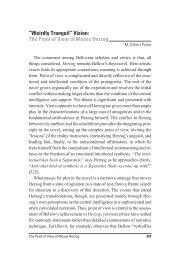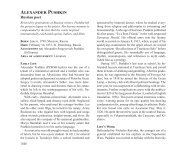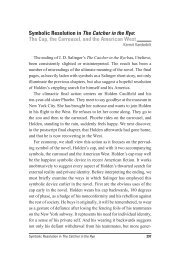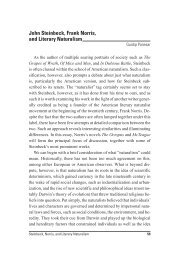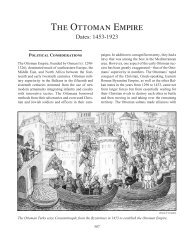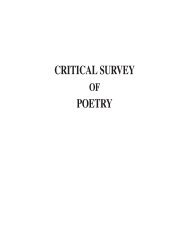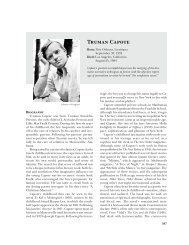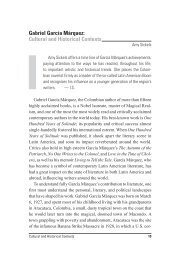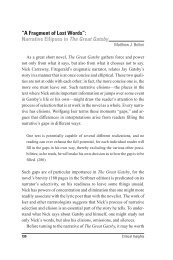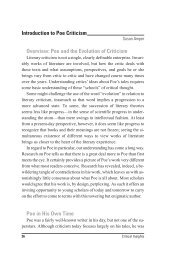The Historical and Social Context of Gwendolyn ... - Salem Press
The Historical and Social Context of Gwendolyn ... - Salem Press
The Historical and Social Context of Gwendolyn ... - Salem Press
You also want an ePaper? Increase the reach of your titles
YUMPU automatically turns print PDFs into web optimized ePapers that Google loves.
us all. . . . she is the continuing storm that walks with the English language<br />
as lions walk with Africa” (Brooks, Report from Part One 30).<br />
From her first book, A Street in Bronzeville (1945), to her final publications,<br />
Brooks’s primary focus was on the lives <strong>of</strong> African Americans<br />
in the context <strong>of</strong> evolving social, cultural, <strong>and</strong> political events in<br />
the United States. Her portraits are most <strong>of</strong>ten based on people from<br />
the South Side <strong>of</strong> Chicago, her home. While it is universally observed<br />
that her poetry underwent a transformation in 1967 after she attended<br />
the Second Black Writers’ Conference at Fisk University, Brooks’s<br />
work is remarkably consistent in the brilliance <strong>of</strong> her wit <strong>and</strong> in her<br />
subtle treatment <strong>of</strong> sound <strong>and</strong> its impact on sense.<br />
It is the marriage <strong>of</strong> politics <strong>and</strong> poetics in Brooks that Elizabeth<br />
Alex<strong>and</strong>er—an important twenty-first-century writer <strong>and</strong> the fourth<br />
inaugural poet—admires in her work. 1 In a thought-provoking essay,<br />
Alex<strong>and</strong>er maintains that Brooks’s In the Mecca serves as a model. It<br />
reminds her that “none <strong>of</strong> us lives outside <strong>of</strong> historical moments” <strong>and</strong><br />
that Brooks “never feared or shirked what she fervently believed was her<br />
responsibility; that sense <strong>of</strong> responsibility shaped her very aesthetic.”<br />
Alex<strong>and</strong>er concludes: “Few poets walk with such integrity” (378-79).<br />
Brooks’s poetry is inextricably grounded in the mid-twentieth-century<br />
social <strong>and</strong> political transformation <strong>of</strong> the United States <strong>and</strong> in art’s potential<br />
to engage with the complexity <strong>and</strong> variety <strong>of</strong> experience in African<br />
American life. Rita Dove has also responded to Brooks’s aesthetic.<br />
Like Brooks, but with a focus on earlier events, her collection Thomas<br />
<strong>and</strong> Beulah (1986) <strong>and</strong> other poems include portraits <strong>of</strong> people in daily<br />
life, <strong>and</strong> American Smooth (2004) presents poems in the voices <strong>of</strong> African<br />
American soldiers.<br />
As a writer <strong>and</strong> teacher, Brooks had a major impact on many writers<br />
<strong>and</strong> scholars. Various anthologies <strong>of</strong> poems include tributes to her,<br />
<strong>and</strong> she edited <strong>and</strong> introduced important collections, including A Broadside<br />
Treasury, 1965-1970, <strong>and</strong> Jump Bad: A New Chicago Anthology<br />
(1971). 2 Finally, hundreds <strong>of</strong> critical discussions have appeared on her<br />
work, reflecting various perspectives in literary theory, such as femi-<br />
22 Critical Insights



